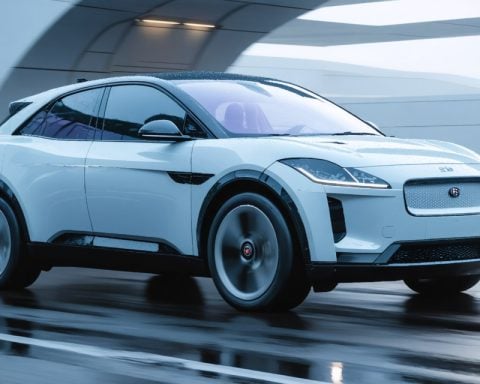- Rivian achieves its first-ever positive gross profit of $170 million in Q4 2024, boosted by its updated R1 vehicle lineup.
- The company reports Q4 revenues of $1.7 billion, despite a net loss of $743 million, an improvement from a $1.5 billion loss the previous year.
- Total vehicle sales reach 51,579 units in 2024, generating $4.5 billion in revenue, with substantial contributions from regulatory credit sales ($260 million in Q4).
- Forecasts for 2025 indicate flat sales, with projections of 46,000 to 51,000 vehicle deliveries due to policy changes and demand challenges.
- New initiatives include offering electric delivery vans to fleet owners and a special edition R1, alongside potential collaboration with Volkswagen.
- Rivian navigates uncertainty amid tariff threats and policy rollbacks, emphasizing resilience in the volatile EV market.
In a surprise twist, Rivian, the electric vehicle maker, has navigated through turbulent waters to finally secure its first-ever positive gross profit in its fourth quarter of 2024. The company reported $170 million in gross profits, a breath of fresh air fueled by the revamped R1 electric vehicle lineup. Yet, dark clouds still hover, threatening what could have been a brighter future.
Picture this: Rivian races to a staggering $1.7 billion in fourth-quarter revenues, a testament to their electric ambitions. Yet, despite this success, the undercurrents of reality manifest in a net loss of $743 million, albeit a significant improvement over last year’s dismal $1.5 billion loss for the same period.
Rivian’s daring push includes selling 51,579 vehicles across 2024, allowing them to amass $4.5 billion in full-year revenues. Regulatory credit sales, echoing strategies from their rival Tesla, have swelled their coffers with an additional $260 million in the last quarter alone.
However, it’s not all smooth driving ahead. The EV maker braces for a bumpy ride as it anticipates flat sales in 2025, projecting between 46,000 and 51,000 vehicle deliveries. Changes in government policies and a challenging demand environment pose threats, yet Rivian remains tenacious.
The company hopes to capitalize on new ventures such as opening its electric delivery van to commercial fleet owners and releasing its special edition R1 built for sandy terrains. Collaborative ventures with automotive giant Volkswagen might just propel them further down the road but recent tariff threats and potential policy rollbacks create uncertainty.
In the fast-paced EV world, Rivian’s journey illustrates a crucial point: triumph is transient, and resilience, a necessity. As the wheels keep turning, the road ahead remains uncertain, but Rivian’s resolve to electrify our future burns bright.
Rivian’s Unexpected Turnaround: Navigating Challenges and Opportunities in the EV Market
How-To Steps & Life Hacks
1. Strategic Fleet Expansion: Rivian’s move to extend its electric delivery van for commercial fleets is a clever strategy. Businesses looking to reduce carbon footprints can follow this model by gradually transitioning their fleet to electric vehicles (EVs) to enjoy long-term savings and sustainability benefits.
2. Maximize Regulatory Credits: Much like Tesla, Rivian has capitalized on selling regulatory credits. Companies can monetize similar sustainability credits, allowing them to reinvest in green technologies and R&D.
Real-World Use Cases
– Commercial Applications: Rivian’s launch of specialized vehicles, such as the delivery van and terrain-ready R1, showcases the adaptability of EVs for diverse commercial needs. Companies in logistics and outdoor industries can leverage these models for efficient, eco-friendly operations.
– Customer Adoption: As Rivian stabilizes, early adopters underscore the tangible benefits of EV ownership—from lower maintenance costs to environmental impacts, setting a precedent for wider consumer acceptance.
Market Forecasts & Industry Trends
The global EV market is projected to grow at a CAGR of over 21% from 2023 to 2030. Despite potential obstacles, Rivian’s commitment to innovation and expansion positions it well to capture significant market share alongside giants like Tesla and Ford.
Reviews & Comparisons
– Rivian vs. Tesla: Rivian’s R1T and R1S are often compared to Tesla’s Model X and Cybertruck. While Tesla offers extensive charging infrastructure and advanced autopilot features, Rivian is praised for build quality and off-road capabilities, providing an edge for adventure enthusiasts.
Controversies & Limitations
Rivian faces challenges such as potential tariffs and policy changes. Additionally, fulfilling pre-order demands and scaling production without compromising quality remains critical.
Features, Specs & Pricing
– R1T: Offers up to 314 miles of range with adjustable air suspension, starting at approximately $73,000.
– R1S: Shares many features with the R1T but with more spacious interiors, ideal for families.
Security & Sustainability
Rivian’s focus on securing materials sustainably, coupled with safety features like Driver+ for hands-free driving assistance, bolster its appeal in the EV sector.
Insights & Predictions
If Rivian successfully navigates supply chain constraints and maintains innovation at its core, it could stand as a formidable competitor in both consumer and commercial EV markets by 2026.
Tutorials & Compatibility
Potential buyers should consider compatibility with home charging solutions and potential future upgrades. Rivian offers user-friendly interfaces and regular software updates to ensure vehicles remain current with advancements.
Pros & Cons Overview
Pros:
– Strong off-road capabilities
– Innovative commercial solutions
– High-quality interiors and safety features
Cons:
– Limited charging network compared to established brands
– High initial purchase price
– Uncertainty due to policy and economic fluctuations
Actionable Recommendations
– Leverage Innovative Models: Consider Rivian’s EVs for both personal and business purposes to reduce your carbon footprint while enjoying state-of-the-art features.
– Stay Informed About Incentives: Keep abreast of government policies or incentives for EV purchasers that could make transitions more affordable.
Stay updated with more innovations in the electric vehicle sector at Rivian and explore comprehensive insights on sustainable automotive solutions.
By making informed choices today, you contribute to a cleaner and more sustainable transportation future.















